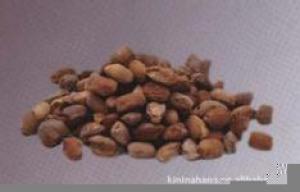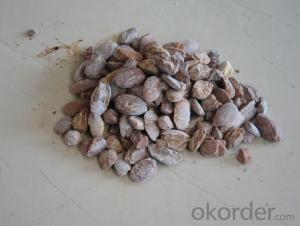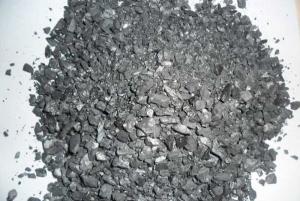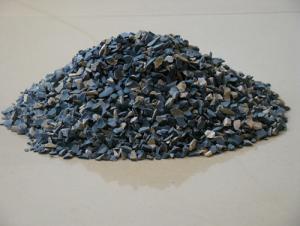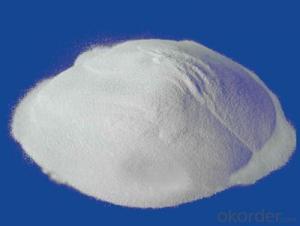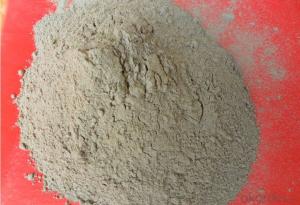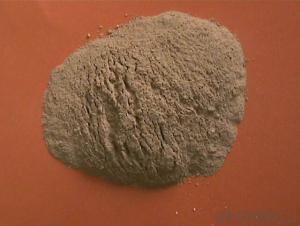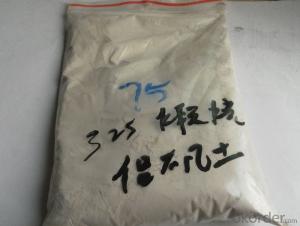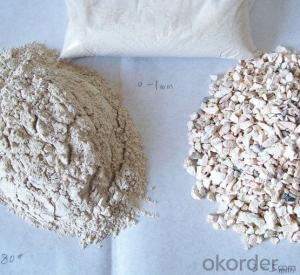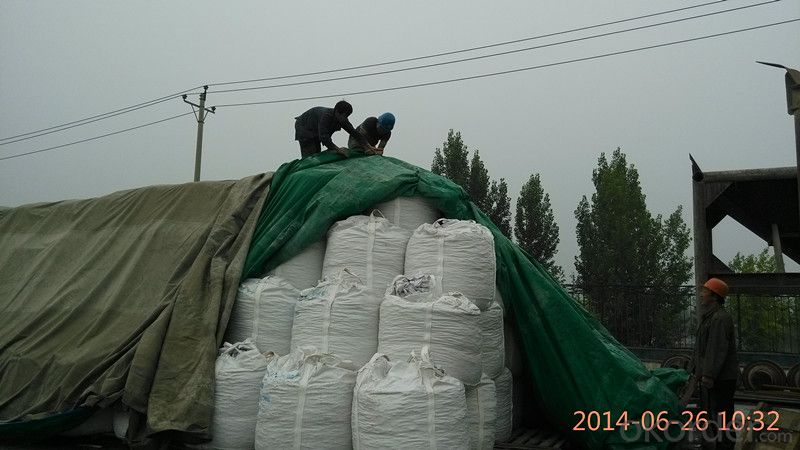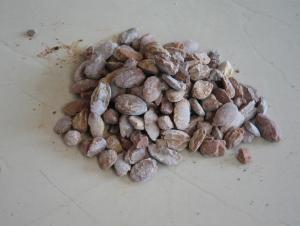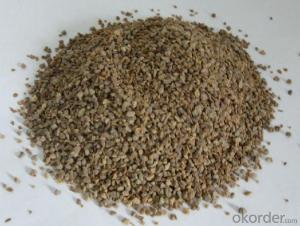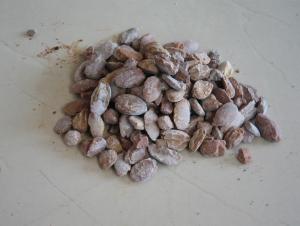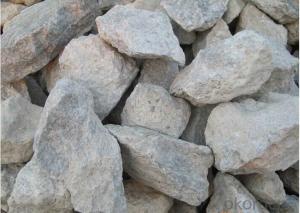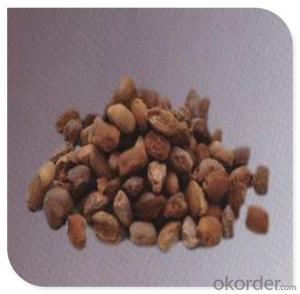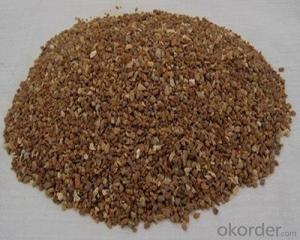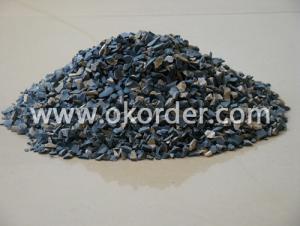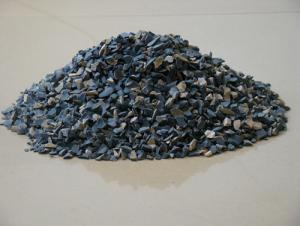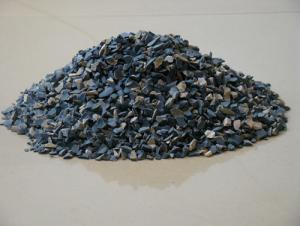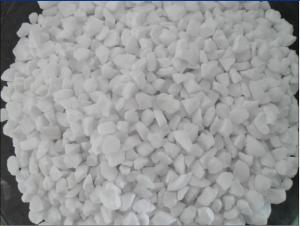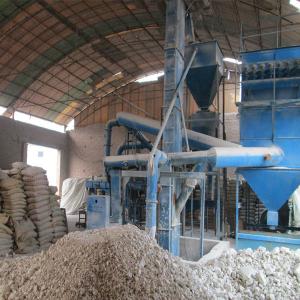Raw Materials for Refractory:Dead Burnt Magnesite 0-30mm
- Loading Port:
- Dalian
- Payment Terms:
- TT OR LC
- Min Order Qty:
- -
- Supply Capability:
- 2000 m.t./month
OKorder Service Pledge
OKorder Financial Service
You Might Also Like
| Item | MgO | SiO2 | CaO | LOI | B.D.(g/cm3) |
| DBM-97 | 97 | 0.7 | 1.4 | 0.2 | 3.2 |
| DBM-96 | 96 | 1.5 | 1.5 | 0.2 | 3.2 |
| DBM-95 | 95 | 2.2 | 1.6 | 0.3 | 3.2 |
| DBM-94 | 94 | 3 | 1.6 | 0.3 | 3.2 |
| DBM-93 | 93 | 3.5 | 1.6 | 0.3 | 3.2 |
| DBM-92 | 92 | 4 | 1.6 | 0.3 | 3.18 |
| DBM-92 | 92 | 4 | 1.6 | 0.3 | 3.18 |
| DBM-91 | 91 | 4.5 | 1.6 | 0.3 | 3.18 |
| DBM-90 | 90 | 4.8 | 2 | 0.3 | 3.18 |
| DBM-87 | 87 | 7 | 2.2 | 0.3 | 3.2 |
Dead burned magnesite- DBM-is produced using selected natural magnesite that is purified and is calcined in a shaft kiln.The final product is used for electric furnacefloors and furnace liner tamping.
Main products level :
0-1mm;1-3mm;3-5mm;0-10mm;0-30mm
50 to 325mesh (90% through)
Product feature:
high temperature performance and high-density, strong anti-permeability ability and easy to rapid sintering, very thin sintered layer,good thermal shock stability, strong slag-resistance, long service life and so on.
Product function:
Apply to the construction of bottom and wall of all kinds steel making electric arc furnace and ferroalloy smelting furnace for hot charging of hot metal and second hand steel
Product usage:
Mainly used in producing common magnesite brick, magnesite aluminum brick, magnesite chrome brick, gunning mix, hot patching mix for converter and EAF ect .
Product Advantage:
Our factory produce the products of the Dead-burned magnesite are selected natural magnesite, it is produced by mine-selecting, purifying, calcimine in shaft kiln. It is an ideal material for unshaped refractory material, the final products are used in open hearth furnace, electric furnace bottom and furnace's lining tamping.
- Q: How to use fire-resistant soil?
- It can live with water, not too sticky. Don't be too thin. It's best to put the stove in the inner wall.
- Q: The mechanism and function of antioxidants in carbon containing composite refractories are briefly described.
- Mechanism analysis of silicon actionWhen silica fume is added to the carbon composite refractory, the phase changes and chemical changes are as follows:<1> Si (s) +C (s) =SiC (s) Delta G ~ =-522+1.50T (kJ)<2> Si (s) +MgO (s) =Si (g) +Mg (g) Delta G ~ =203.9-0.13T (kJ)<3> 2Si (s) +CO (g) =SiC (s) +SiO (g) Delta G ~ =-963.2+0.31T (kJ)<4> SiC (s) +CO (g) =SiO (g) +2C (s) Delta G ~ =81.47-0.15T (kJ)<5> SiO (g) +CO (g) =SiO2 (s) +C (s) Delta G ~ =-668.8+0.33T (kJ)From the above diagram and the reactions seen at high temperatures has joined the Si SiO and Mg volatiles, but <4> and <5> reaction have played a role in inhibiting carbon oxidation, and the condensation of SiO2 to a certain extent the role of protective film.The total reaction process is CO reduction to C, and there is a certain volume expansion, so that the pores are blocked and the density of bricks is increased. Therefore, the oxidation resistance of brick is improved.
- Q: Does anyone know what kind of light fireproof materials are there?
- 二, 1, Gypsum plaster board With the building plaster as main raw material, gypsum plaster board is a kind of processed plate made by a special board for protective with an addition of additives and fibers as board core. Gypsum plaster board is characterized by light weight, sound insulation, heat insulation, strong processing performance and simple construction method. 2, Gypsum block Gypsum block is a kind of lightweight building gypsum product which is mainly made of building gypsum, and by adding water, stirring, casting and drying. During the process, , the fiber reinforced materials or light aggregates are allowed in, and the foaming agent can also be added. It has many advantages, such as sound insulation and fire prevention, convenient construction and so on. It is a kind of new and healthy wall material which produces low carbon, enhances environmental protection, and caters to the the times. 3, Fly ash brick is a new type of wall material, and bulk density is one of the main technical indexes. The weight of bulk density can be controlled according to the need of construction and adjustment of technical formula. The dry bulk density of the fly ash brick is about 1540 to 1640 kg / m 3, slightly lighter than the clay brick (1601800 kg /m 3). The flexural and compressive strength of fly ash brick is mainly determined by the production process, the formula and the hydrothermal synthesis reaction mode as well as the need of construction. According to the standards of architectural material industry (JC239 - 2001) released by People's Republic of China, the average value of the flexural strength is 2.5 ~ 6.2Mpa, compressive strength is between 10 ~ 30Mpa. I hope this will be helpful to you
- Q: which kind of refractory is used in golden smelting furnace? How about his using temperature
- generally the price of the quartz sand refractory material is higher and the temperature can meet the requirement of 2000 degree.
- Q: Who knows the fire rating of fire?partition with steel stud?
- Cement board wall of steel stud: it is used for walls with ceramic in kitchens, restroom, disinfect room, etc. If single-sided tile is made, cement pressure plate can be used on one side. Gypsum board is used on the other side. Fire?rating is A1. CaSo4.2H2O is molecular structural formula of gypsum which contains 20% water, crystal water and free water. When 10% water slowly evaporates on the flame surface, there is still 10% crystal water. Itself is grade A fire retardant material. 1 hour. It is in line with the fireproof test standard of national building materials. It can reach up to 4 hours at most.
- Q: The classification of fire-resistant material
- There are various refractory materials classified according to the chemical properties of material: Min< manufacturing technique: neutral refractory materials, pipes, etc. Standard model: baidu.hiphotos;8 simatic carbon composite refractory material zirconia based refractory material special fire-proof material 6; or a acute angle of 50~70° and material forms. 3.
- Q: What's the classification of refractory material?
- Magnesium aluminum is complex and mainly seeing what classification standard is like according to the appearance shape can be divided into two categories, setting and not setting according to the acid alkali can be divided into acidic, magnesia, high aluminum, ramming expected, spinel, spray coating, plastic, just the quality of the jade, daub material according to the chemical composition is divided into, such as clay, neutral and alkaline according to the operation mode can be divided into different castable, magnesium, calcium, magnesium chrome
- Q: Who can tell somthing about how to choose fire resistant rating of fire resistance rolling shutter doors?
- According to the fire endurance, fireproof doors can be divided into A-grade, B-grade and C-grade, whose fire endurance should not be less 1.2h, 0.9h and 0.6h respectively. A-grade fireproof doors can be even applied to the material whose fire resistant rating is at secondary level. "Building Regulations" mention that fire resisting shutter can be used as partition of fire?compartment in those places where setting firewalls is not so easy. When using fire resisting shutter whose fire endurance includes unexposed surface temperature rise, its fire endurance should not be less than 3 hours. When using fire resisting shutter whose fire endurance doesn't include unexposed surface temperature rise, it should install closed independent automatic sprinkler system for protection on both sides, and the sprinkler sholud last at least 3 hours.
- Q: What is the the best ratio of mortar in refractory cement?
- Specifical proportions are as following: 42.5R cement is 425 rapid hardening cement. Using the 425 cement to compound the mortar. The reducion of cement will naturally impact the workability of the mortar. The mix design standard of the mortar specifies the minimum amount of cement is not less than 200kg / m3. If it is composite mortar, and the strength and workability can be ensured, it is Ok to use 425 to compound. You can look for instructions of mixing proportion of mortar online as a reference.
Send your message to us
Raw Materials for Refractory:Dead Burnt Magnesite 0-30mm
- Loading Port:
- Dalian
- Payment Terms:
- TT OR LC
- Min Order Qty:
- -
- Supply Capability:
- 2000 m.t./month
OKorder Service Pledge
OKorder Financial Service
Similar products
Hot products
Hot Searches
Related keywords
